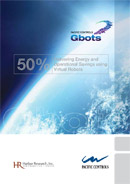
Gbots
50% of delivering energy and operational savings by using virtual robots.
Pacific Controls Gbots
The future of smart services delivery
Driving service delivery & customer support convergence

Harbor Research was recently given the opportunity to examine prototypes of Gbots™, software from Pacific Controls that creates a refreshingly new approach for equipment and systems support. Pacific Controls’ technology sidesteps the current marketplace noise and clutter surrounding device connectivity by deploying smart software agents - Gbots™ - as an integral element of their Galaxy™ service delivery platform, thus viewing customer equipment service and system support concerns as a challenge that can be addressed by a single, scalable solution. In so doing, the company is defining the future of smart systems for buildings, energy and infrastructure.
The term “convergence” implies unification, but you wouldn’t know it from today’s so-called “smart” building systems technology - a fragmented landscape full of narrow point-solutions and software/platform incompatibility.

Amid all the confusion, a new family of software tools from Pacific Controls finally takes a comprehensive approach to managed services and equipment health for building and energy systems. Gbots™ are unobtrusive automated tools for customer support integrated into Pacific Controls’ Galaxy™ services delivery platform. These new technologies will drive next generation equipment maintenance and customer service, enabling early fault detection and real-time predictive and self-healing systems. Ultimately, Pacific Controls’ approach treats management concerns about building systems - from comfort and convenience to performance and security - as a unified challenge that can be addressed by a single, scalable solution. In taking this perspective, Pacific Controls has raised the bar for smart services delivery.
The future that has never happened
Visions of “Smart Buildings” have been in abundant supply for decades now. Buckminster Fuller, the famous creator of the geodesic dome (among many other things), was writing about intelligent homes and buildings as early as the 1930s. The “automated intelligent building” has been an obsession since at least the 1960s. The software industry has a term for such promises: vaporware. In the typical building of today, smart devices and equipment systems have not reached their full potential. In many respects, the value of integration today is not worth much more than it was twenty years ago.

Industry participants consequently now view the “intelligent building” as more of a marketing slogan for over promising on what technology can deliver to buildings and infrastructure. For many building owners, the phrase “building automation” has become so problematic that it now provokes scepticism rather than visions of innovation. Yes, we’ve had a long history of futurism, but to date progress has been incremental at best.
It is clear that customers seeking to invest in intelligent building technology are demanding wider integration of systems within a building, particularly the integration of IT and control systems. This goal has become acute with the emergence of energy within facilities as a key cost driver and sustainability concern.
For further details, please view our e-brochure.

